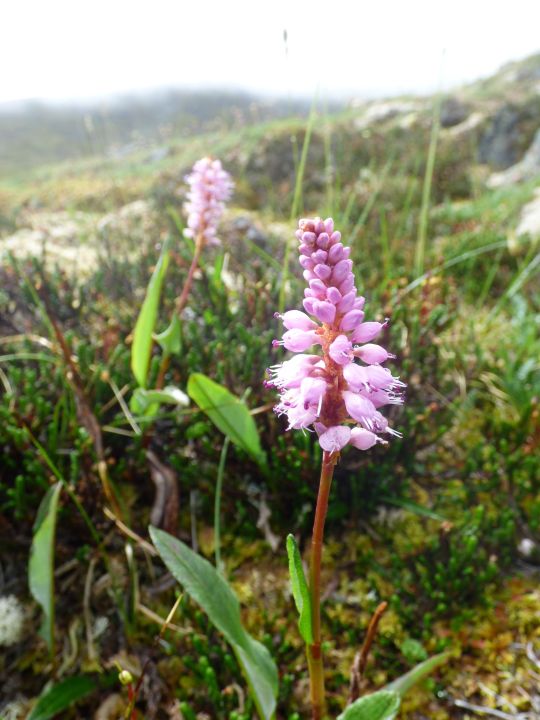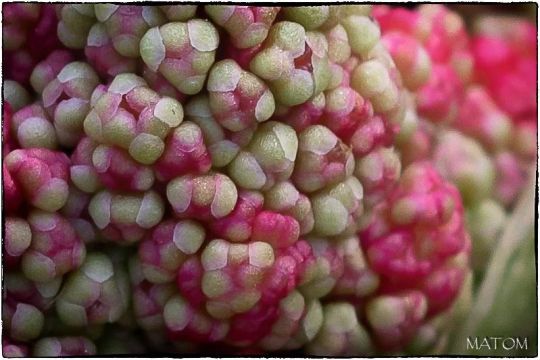#polygonaceae
Text


Eriogonum arborescens
Eriogonums belong to the family Polygonaceae, and they are commonly known as "wild buckwheat". California has many species, including Eriogonum arborescens, from the Channel Islands off the coast of Southern California. Many species in the genus are more herbaceous than woody, but this one is a bush up to 5 feet tall (1.5 m). It looks like a miniature tree, as is implied by its name "arborescens". It produces many clusters of tiny flowers over a long period in the summer and fall, and these are initially pale pink. Later in the season, the brown-tinged old flowers combine with the pink new ones to give a salmon-tinged effect, as seen in the photo. A great species for a dry-summer landscape!
-Brian
19 notes
·
View notes
Text


B – Bistorta officinalis Delarbre (= Polygonum b.) – Poligono bistorta Polygonaceae
22 notes
·
View notes
Text

Persicaria hydropiperoides / Swamp Smartweed at the Sarah P. Duke Gardens at Duke University in Durham, NC
#Persicaria hydropiperoides#persicaria#Polygonaceae#Swamp Smartweed#Smartweed#False waterpepper#Native plants#Native flowers#Wildflowers#Plants#Flowers#Nature photography#photography#photographers on tumblr#Sarah P. Duke Gardens#Duke Gardens#Duke University#Durham#Durham NC#North Carolina#🌺🌻
4 notes
·
View notes
Text

Bistorta plumosa (Polygonaceae)
meadow bistort
You know what? It's been a while since I posted a vascular plant and these were one of my favourites from the bioblitz.
near Koidern | July 18, 2022
#plants#botany#Bistorta#Bistorta plumosa#Polygonaceae#Caryophyllales#flower#flowers#meadow bistort#flora of YT#photo thursday#on fleek in beaver creek
74 notes
·
View notes
Text

Pileurtbladbille (Gastrophysa polygoni)
På kruset skræppe (Rumex crispus).
Gastrophysa polygoni (Gastrophysa polygoni)
On Curled Dock (Rumex crispus).
#Pileurtbladbille#Gastrophysa polygoni#Gastrophysa#Bladbille#Chrysomelidae#Bille#Beetle#Coleoptera#Insekt#Insect#Skruset skræppe#Skræppe#Rumex crispus#Rumex#Curled Dock#Dock#Plante#Plant#Polygonaceae#Syre#Field#Mark#Topbjerg#Sommer#Summer
23 notes
·
View notes
Text


5/24/24
#plant#flowering plant#Rumex acetosella#sheep's sorrel#eucidots#Caryophyllales#Polygonaceae#edible plant
0 notes
Text
#2195 - Rumex obtusifolius - Broad-leaved Dock


AKA bitter dock, , bluntleaf dock, dock leaf, dockens or butter dock. Named Rumex obtusifolius by Carl Linnaeus, and surprsingly has kept it, compared to some of the taxonomic nightmares I've described before. Rumex was Pliny's name for sorrel, while obtusifolius means 'obtuse-leaved'.
A highly invasive weed found on all temperate continents. In its native range in Europe the young leaves have been used in salads, or as a substitute in stuffed graped leaves, or squeezed to treat nettle stings. The seeds can be ground into flour and the roots was boiled to treat boils.
Athenree Gorge, Aotearoa
1 note
·
View note
Text
Pau-formiga – Triplaris americana

Nome Científico:Triplaris americana
Nomes Populares: Pau-formiga, Formigueiro, Novateiro, Pajeú, Paliteiro, Pau-de-formiga, Pau-de-novato, Pau-de-tachi, Tachi, Tangarana, Taquari
Família: Polygonaceae
Categoria: Árvores, Árvores Ornamentais
Clima: Equatorial, Subtropical, Tropical
Origem: América do Sul, Brasil, Paraguai
Altura: acima de 12 metros
Luminosidade: Sol Pleno
Ciclo de Vida: Perene
Sobre a Pau-formiga ou Pau-de-novato
Devido à sua copa colunar e beleza no florescimento e frutificação, é amplamente usada no paisagismo, sendo útil para arborização de ruas estreitas desprovidas de rede eléctrica.
A Pau-formiga é muito útil também para recuperação de florestas ciliares.
O nome popular desta espécie (Pau-formiga) é proveniente de sua associação com formigas no ambiente natural, que constroem seus ninhos no tronco oco, protegendo assim as plantas de outros predadores.

Pau-formiga atinge tamanho padrão de comercialização em menos de 2 anos.
Pau-formiga deve ser cultivado sob sol pleno, em solo fértil, profundo, húmido, enriquecido com matéria orgânica e irrigado regularmente.
A floração ocorre no inverno e início da primavera e é bastante durável.
De tronco oco e abrigo para formigas (daí a razão do nome comum), o pau-formiga pode chegar a 20 metros de altura.
As podas são desaconselhadas por descaracterizarem a copa.
Transplantar quando atingir 10 cm de altura para sacos de cultivo com substrato semelhante ao do plantio da muda, deixando em cultivo protegido, realizando regas periódicas.
Uso medicinal: A casca é utilizada contra disenteria.
Outros usos: A espécie é ornamental devido a sua bela floração e formato da copa, sendo empregada no paisagismo. A casca contém tanino que pode ser aplicado em diferentes usos.
Mais info: https://pt.wikipedia.org/wiki/Triplaris_americana
Read the full article
0 notes
Photo

Blüte #rhabarber, #blüte, #bluete, #garten, #rheumrharbarbarum, #rheum, #knöterichgewächse, #polygonaceae, #nelkenartige, #caryphyllales, #pflanze, #plant, #maricthomas, #natom, #sanktveitindersüdsteiermark, #sanktveitamvogau, #pflanzephotos (hier: Sankt Veit Am Vogau, Steiermark, Austria) https://www.instagram.com/p/CrZLD46IexI/?igshid=NGJjMDIxMWI=
#rhabarber#blüte#bluete#garten#rheumrharbarbarum#rheum#knöterichgewächse#polygonaceae#nelkenartige#caryphyllales#pflanze#plant#maricthomas#natom#sanktveitindersüdsteiermark#sanktveitamvogau#pflanzephotos
0 notes
Photo

Scientific Name: Eriogonum longifolium
Common Name(s): Longleaf buckwheat
Family: Polygonaceae (buckwheat)
Life Cycle: Perennial
Leaf Retention: Basal leaves
Habit: Forb
USDA L48 Native Status: Native
Location: Plano, Texas
Season(s): Fall
#Eriogonum longifolium#longleaf buckwheat#Polygonaceae#perennial#forb#native#Plano#Texas#fall#autumn#flower#green#plantblr
0 notes
Text


Eriogonum crocatum
California is home to many species of Eriogonum, plant in the Polygonaceae commonly known as buckwheats or wild buckwheats. These range from tiny ground-hugging alpine species to substantial shrubs, but in all cases they have clusters of tiny flowers. The plant pictured is Eriogonum crocatum, known as the saffron buckwheat. It features a striking combination of felted white leaves and greenish-yellow flowers, and it is native to Ventura County and western Los Angeles County in southern California.
-Brian
11 notes
·
View notes
Text



B - Bistorta officinalis Delarbre (= Polygonum bistorta L.) - Poligono bistorta (Polygonaceae)
17 notes
·
View notes
Text

Erigonum allenii 'Little Rascal' / 'Little Rascal' Shale Barren Buckwheat at the Sarah P. Duke Gardens at Duke University in Durham, NC
#Erigonum allenii 'Little Rascal'#Erigonum allenii#Erigonum#Polygonaceae#Little Rascal shale barren Buckwheat#Shale barren Buckwheat#Buckwheat#Native plants#Native flowers#Plants#Flowers#Wildflowers#Nature photography#photography#photographers on tumblr#Sarah P. Duke Gardens#Duke Gardens#Duke University#Durham#Durham NC#North Carolina#🌺🌻
6 notes
·
View notes
Text


Unknown, Plants of the Polygonaceae family: flowering stem. Watercolor. Japan
Welcome collection
316 notes
·
View notes
Text

Albert Renger- Patzsch
Polygonaceae, Blattadern
53 notes
·
View notes
Text

黄実千両|黄実仙蓼[Kiminosenryō]
Sarcandra glabra f. flava
黄[Ki] : Yellow
実[Mi] : Fruit
(の[No]) : Of
千[Sen] : One thousand
両[Ryō] : A unit of currency used in the past
仙[Sen] : Immortal mountain wizard in Taoism; hermit
蓼[Ryō] : Knotweed(Polygonaceae)
The normal Senryō produces red fruits.
昔は盲人に特別の位を与えたものである。よく何市、何市とあるが、あれも市名といって、盲人の位の一つで、一番下である。しかし何といっても一番よいのは撿挍であって、昔は撿挍になるには千両の金を納めなければならなかった。その代り十万石の大名に相当する資格が与えられていた。その次は勾当で、これは撿挍の半分位の資格であった。
[Mukashi wa mōjin ni tokubetsu no kurai wo ataeta mono de aru. Yoku nani-ichi, nani-ichi to aru ga, are mo ichina to itte, mōjin no kurai no hitotsu de, ichiban shita de aru. Shikashi nan to ittemo ichiban yoi no wa kengyō de atte, mukashi wa kengyō ni naru niwa senryō no kane wo osame nakereba naranakatta. Sono kawari jūman-goku no daimyō ni sōtō suru shikaku ga atae rarete ita. Sono tsugi wa kōtō de, kore wa kengyō no hanbun kurai no shikaku de atta.]
In the past, (statesmen) gave special statuses to blind people. It is often said "So-and-so-ichi" "So-and-so-ichi," and this is called Ichina, which is one of the statuses of blind people, the lowest. After all, the best is Kengyō, and in the old days, to become Kengyō, they had to pay one thousand ryō. Instead, they were qualified to the equivalent of a ten thousand koku feudal lord. The next position is Kōtō, which was about half as qualified as Kengyō.
From Mukashi no mōjin to gaikoku no mōjin(The blind of old and the blind of foreign lands) by Miyagi Michio
Source: https://www.aozora.gr.jp/cards/001288/files/47117_29089.html (ja)
https://en.wikipedia.org/wiki/Zatoichi_(disambiguation)
https://en.wikipedia.org/wiki/Koku
https://en.wikipedia.org/wiki/Michio_Miyagi
https://www.youtube.com/watch?v=gND5pFB9nmU
(About a certain Kengyō)
https://mainichi.jp/english/articles/20200611/p2a/00m/0na/009000c
12 notes
·
View notes